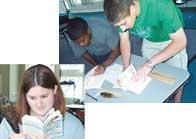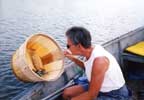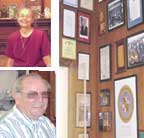|
|
 |
||||
|
Volume 13, Issue 18 ~ May 5-11, 2005
|
|||||
Envirothon gets kids down in the dirt Carrie Steele Most high school girls won’t go near a snake, let alone a colorful scarlet king snake. But last week at Calvert County’s Envirothon competition, two students from Patuxent High School were examining one up close, and with great interest. Of course, the reptile was safely nestled in a tub behind Plexiglas so that the girls could observe its colorations and head shape for identification. Still, the snake was just one of 10 animals the girls’ team had to identify. Such were lessons in biology and natural science that Calvert high schools applied in a series of exams at the annual Envirothon competition, which challenges students to master the art and science of analyzing our natural resources. High school teams of six compete first at the county level, sponsored by the soil conservation districts (Anne Arundel schools, which were the subject of a story in Vol. XII, No. 18, did the same exam). Then the winners — this year a team from Calvert High School — travel to the state competition, to be held in June at Harford Glen. Last year, Patuxent High School made it to the state finals, where a school from Montgomery County placed first. Calvert schools have been training their environment-minded students to compete in the Envirothon for 13 years. Each year, Envirothon’s high schoolers study with field experts and take an exam on aquatics, wildlife, forestry and soils. This year’s fifth topic, which changes every year, was historical and cultural landscapes, where students delved into how people change their surrounding soils and environments. Students learn how to use specialized tools, such as a clinometer, which they used to measure a 74-foot-tall tree within three or four feet. They also interpret their answers, such as figuring out what a plot of land could be used for — farming? a playground? — after determining slope. “The students get to meet real scientists and learn about their jobs. Kids find out what foresters actually do and then decide if these are fields they might want to go into,” said Linda Subda of Chespax, Calvert’s environmental education program for the public schools. “The kids see what people do on a regular basis,” said Beth Kawecki, biology teacher at Northern High School. “Not only can they get career direction, but they just have fun. It’s enjoyable.” For one day, Calvert’s teens became marine scientists, identifying two formaldehyde-preserved fish using a dichotomous key — a series of characteristic questions about fins, color, scales, size, shape and more that leads them to the correct species. 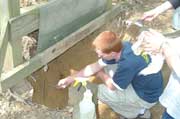 There’s a list of 30 fish to choose from, said expert Scott McGuire, of the Chesapeake Biological Lab, who had hosted the students earlier in the year for training. “And they go through the series of questions, like, does it have scales or no scales?” Students poured over the gizzard shad and yellow perch McGuire had picked out for them as they learned to put a name with a fish. There’s a list of 30 fish to choose from, said expert Scott McGuire, of the Chesapeake Biological Lab, who had hosted the students earlier in the year for training. “And they go through the series of questions, like, does it have scales or no scales?” Students poured over the gizzard shad and yellow perch McGuire had picked out for them as they learned to put a name with a fish.Students became naturalists, as they consulted guidebooks to identify a series of live and past animals. In addition to the scarlet king snake, there was a taxidermied mink and Merlin falcon, as well as a live spotted salamander, all surrounded by field guidebooks. “The program’s so well received,” said Bill Phalen, president of the Board of Education. “The students, mostly advanced placement students, are doing fantastic.” Students thought the competition was fun, even though they had to study. Junior Shannon Genthner, from Patuxent, said the exams were harder than she’d expected. During their three-hour training sessions for each part of the exam, students had to absorb and retain a lot of new information and skills very quickly. “It was a little challenging,” said Erik Salzman, a junior from Patuxent who plans to pursue an environmental science degree in college. The winning team of the Maryland State Envirothon in Harford Glen will move on to the 2005 Canon Envirothon in Springfield, Missouri, where they’ll compete for scholarships. Last year, Maryland teams finished 11th overall in the country.
Mr. Maryland’s office door is still open by Becky Bartlett Hutchison If Mr. Maryland could rise from the grave, he could go to work today. Louis Goldstein’s office has been transported lock, stock and barrel — from walls to chandelier to nameplate — from the Maryland Treasury building in Annapolis to the Jefferson Patterson Park and Museum Visitor Center, where it’s open for you to visit. Photographs, awards and certificates cover its original high ceiling and walls. Here is Goldstein smiling with President John F. Kennedy, standing with Queen Elizabeth II and Prince Philip, talking to Henry Kissinger, shaking hands with President Bill Clinton. Alongside all these eminences is pictured the first U-Haul truck featuring Maryland as a graphic destination. More than a dozen ceremonial groundbreaking shovels lean against both sides of the doorway, and souvenirs from all over the country share space with books, pens and whatnots. Each item in the room — including the original fireplace, ceiling tiles and carpet as well as the combined desk and conference table that Goldstein put together from separate table legs and three table tops — has been placed exactly as they were when Goldstein left work for the July Fourth holiday in 1998. Goldstein, son of a successful immigrant peddler who arrived in Calvert County by steamboat, rose to become Maryland’s favorite son. For close to 55 years, he served Calvert County and Maryland, first as a state delegate in 1939, then as a Marine in World War II, returning to win election as a state senator in 1947. Elected comptroller in 1959, he kept the job for 39 years; upon his death on July 3, 1998, he was planning yet another campaign. How did the holder of an obscure, if powerful office, become Maryland’s most visible public official? Goldstein loved politics and people, believing, as he told Bay Weekly in 1996, that “you can’t sit in Annapolis and get the real feel of a situation.” He wanted to “touch, feel and see” life. So he took politics to where the people were, often attending several events in a day at which he’d greet one and all with his big smile and warm handshake and pass out his trademark gold coins stamped with the words “Bless you all real good.” 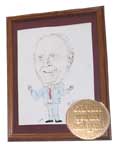 Stopping Time Stopping TimeAfter Goldstein’s death, his long-time assistant Bobby Swann was appointed to fill out his term. On his first day in the new job, Swann said, he looked around, and wondered, “What are we going to do with all this stuff?” Each object in the room represented a facet of Goldstein’s illustrious career and more than a bit of Maryland history. “Somehow or another,” he realized, “we needed to preserve what was there.” That’s how Bobby Swann came to lead the move to preserve Louis Goldstein’s office Once Swann came up with the notion of preserving the office, he had to find a place to put it. Washington College, Goldstein’s undergraduate school, was at the top of his list. But Wayne Clark, Maryland museums director, suggested Jefferson Patterson, located in Goldstein’s beloved home of Calvert County. With its proposed Goldstein room, the park and museum got the money for expanding its visitor center. Gov. Parris Glendening added the project in his budget for 1999. With the Calvert County delegation’s support, funding was passed by the General Assembly. At this point, Jefferson Patterson conservationist Betty Seifert and a group of volunteers began the tedious task of identifying and packing the contents of the Goldstein office. First, pictures were taken of the whole room and its contents. All items were then catalogued, cleaned, labeled and carefully prepared for the move. Everything but the proverbial kitchen sink was taken apart and packed away and moved to Jefferson Patterson. Only “bare concrete and walls were left,” Swann said. With the visitor center expanded, Seifert — with her conservation staff and volunteers and the museum’s maintenance crew — went to work. Working throughout the first half of 2004, they finished on July 2, just in time to have the whole office and its contents in place by the official opening on July 3, 2004, the sixth anniversary of Goldstein’s death. The ‘before’ photos were “lifesavers,” Seifert said of the “faithful re-creation” of the office — even down to the Public Works notebook, covered with paper clips and notes, which lies open on Goldstein’s desk for the Wednesday July 8, 1998, meeting. “People come in and are amazed,” said Seifert. “Jaws drop when they see how the walls are so completely covered” with plaques, certificates, artwork and photographs of Goldstein attending historical events and shaking hands with presidents, queens, governors and other politicians. Then you notice other, more ordinary items and realize that this extraordinary and accomplished man valued all of life. See for yourself Wednesday through Sunday until October 15, when the museum closes for the winter: 410-586-8501; www.jefpat.org. 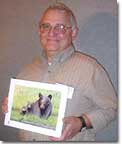 Art for Wildlife’s Sake Art for Wildlife’s SakeThese stamps won’t pay your postage — but they make money for conservation by Carrie Steele Stamps bring art into mundane life. Stop by your local post office, and you’re confronted with an array of stamp art to choose from. Pen-pals and bill-payers alike attach the art to their parcels, perhaps without a second look. But the collector’s eye is on art. Back before postal stamps were much to look at, America’s artists set their hands to designing another kind of stamp that, in half a century, has become an annual tradition as well as a big moneymaker. That’s why each year ducks and bears get their portraits painted. As well as pleasing collectors and showcasing artists, wildlife stamps have supported conservation since the days of President Franklin Roosevelt, who started the Federal Duck Stamp program during the Great Depression to buy land for federal wildlife refuges. Artists have been depicting waterfowl for the Maryland stamp since 1974, when John Taylor of Edgewater won for his illustration of mallards. Since then, we’ve seen Canada geese, wood ducks, hooded mergansers, buffleheads, American widgeons and, this year, ruddy ducks. Wilhelm Goebel’s painting of a ruddy duck beat out 35 other entries in the 2005 Maryland Migratory Game Bird Stamp Design Contest last month. A two-time victor, Goebel lives in Salisbury. Stamps such as his and Taylor’s have raised more than $4 million for creating and maintaining waterfowl migration and wintering habitats. Other states also have stamp contests, but Maryland’s is the fourth oldest in the United States. 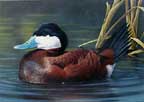 The waterfowl stamps, at $9 each, buy hunters passports to shoot not only waterfowl but all migratory game birds, including doves, rails, coots, snipe and woodcock. Non-game migratory birds are strictly off limits, which is why mute swans have been protected so far, along with tundra swans, herons and osprey. The waterfowl stamps, at $9 each, buy hunters passports to shoot not only waterfowl but all migratory game birds, including doves, rails, coots, snipe and woodcock. Non-game migratory birds are strictly off limits, which is why mute swans have been protected so far, along with tundra swans, herons and osprey.Hunters don’t have to paste the art stamp on their license anymore, but they must have the receipt in order to shoot. Maryland’s only other wildlife stamp, the $5 black bear stamp is exclusively a collector’s item. Hunters can target bears at two intervals in the fall, but they don’t need Pennsylvanian Al Dornisch’s 2005 prize-winning stamp to shoot. Instead, they’ll pay a fee and take their chances in a lottery. The Black Bear Stamp is purely a conservation collectible, funding the Black Bear Compensation Fund to pay back farmers in whose fields or on whose livestock bears have dined. Dornisch’s mother bear, with two cubs peeking out from behind her, walked through a field of flowers, not corn, to beat out 17 other entries last month in the Ninth Annual Maryland Black Bear Conservation Stamp Design Contest. Order this year’s bear stamp from the artist at 814-772-5333; e-mail [email protected]. Order this year’s duck stamp at 410-749-9564; [email protected] |
|||||
|
© COPYRIGHT 2004 by New Bay Enterprises, Inc. All rights reserved. |

